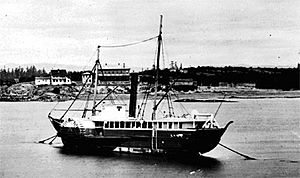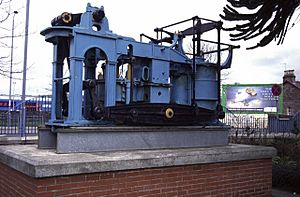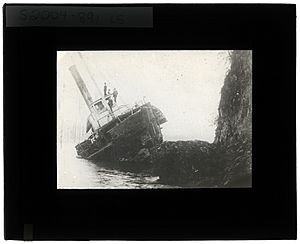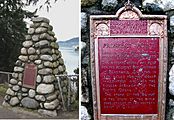Beaver (steamship) facts for kids

Beaver about 1870
|
|
Quick facts for kids History |
|
|---|---|
| Name | Beaver |
| Builder | Wigram & Green, Blackwall Yard, London |
| Laid down | London, England |
| Launched | 9 May 1835 |
| In service | 1835-1888 |
| Fate | Wrecked 25 July 1888 |
| General characteristics | |
| Type | Sidewheel paddle steamer |
| Tonnage | 109 tons |
| Length | 101 ft 9 in (31.01 m) |
| Beam | 33 ft (10 m) |
| Draft | 8 ft 6 in (2.59 m) |
| Propulsion |
|
| Sail plan | Brigantine |
| Armament | 4 brass cannons |
Beaver was a steamship originally owned and operated by the Hudson’s Bay Company. She was the first steamship to operate in the Pacific Northwest of North America, and made remote parts of the west coast of Canada accessible for maritime fur trading. At one point she was chartered by the Royal Navy for surveying the coastline of British Columbia. She served off the coast from 1836 until 1888, when she was wrecked.
Construction and delivery
Beaver was built in Blackwall, England of British oak, elm, greenheart and teak, and was copper-fastened and sheathed. Her length was 101 feet (31 m), and the beam over her paddle boxes was 33 feet (10 m). She was launched at Blackwall Yard on 9 May 1835 and left London on 29 August under the command of Captain David Home, and with the company's barque, Columbia, built at the same time and commanded by Captain Darby. Beaver was outfitted as a brig for the passage out, paddles unshipped, and came out via Cape Horn under sail alone. After calling at the Juan Fernández Islands and Honolulu, she arrived off the Columbia River on 18 March 1836 and anchored off Fort Vancouver on 10 April. Here the paddles were shipped and boilers and engines connected.
Service
Beaver served trading posts maintained by the Hudson's Bay Company between the Columbia River and Russian America (Alaska) and played an important role in helping maintain British control in British Columbia during the Fraser Canyon Gold Rush of 1858–59. In 1862 the Royal Navy chartered her to survey and chart the coast of the Colony of British Columbia. She also provided assistance to the Royal Navy at Bute Inlet during the Chilcotin War.
Initially she had a rectangular boiler, generating steam pressure at under 3 psi, and was fed by seawater. Boulton and Watt engines are not pressure engines, rather they are vacuum engines. (Salt water feed was common in the early days and could be done with low pressure and frequent boiler blowdowns to prevent salt scale build up on the plates.) The salt water played havoc with the boilers as the salinity rusted the wall thickness of the boiler, which would rot out. Beaver had to have a new boiler every seven years or so and went through multiple installations over her career. Over time the boiler pressure was increased, and 36 inch diameter cylinders replaced the original 42 inch cylinders.
Beaver played roles in the establishment of coal mines at Fort Rupert, and later in 1853, Nanaimo. She helped the Hudson's Bay Company establish Fort Victoria as a post in 1843. She would also ferry dignitaries such as the Governor back and forth between the Colony of Vancouver Island and the mainland, which until 1858 and the establishment of the Colony of British Columbia had come to be known as New Caledonia after the Oregon Treaty of 1846.
In her later life Beaver burned coal and would hire young men of the Skwxwu7mesh (Squamish) people of North Vancouver to work the holds as coal passers. The Hudson's Bay Company finally sold her in 1874.
Loss
A consortium that became the British Columbia Towing and Transportation Company in 1874 purchased her, and used her as a towboat until 25 July 1888. On that day an inebriated crew ran her aground on rocks in Burrard Inlet at Prospect Point in Vancouver's Stanley Park. The wreck finally sank in July 1892 when the wake of the passing steamer Yosemite struck it, but only after enterprising locals had stripped much of the wreck for souvenirs. The Vancouver Maritime Museum houses a collection of Beaver remnants including the boiler and two drive shafts for the paddle wheels, one raised in the 1960s and the other returned from a collection in Tacoma, along with the boiler. A plaque commemorates the site of the sinking. Divers surveyed the wreck in the 1960s. However, when the Underwater Archaeological Society of BC did so in the 1990s, they found she had mostly disintegrated due to rot and currents.
Image gallery
-
Plaque commemorating Beaver in Stanley Park, Vancouver.




